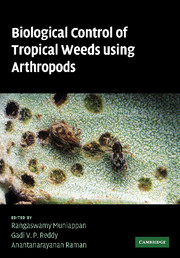Book contents
- Frontmatter
- Contents
- List of contributors
- Acknowledgments
- 1 Biological control of weeds in the tropics and sustainability
- 2 Acacia nilotica ssp. indica (L.) Willd. ex Del. (Mimosaceae)
- 3 Australian Acacia species (Mimosaceae) in South Africa
- 4 Ageratina adenophora (Sprengel) King and Robinson (Asteraceae)
- 5 Azolla filiculoides Lamarck (Azollaceae)
- 6 Cabomba caroliniana Gray (Cabombaceae)
- 7 Invasive cactus species (Cactaceae)
- 8 Chromolaena odorata (L.) King and Robinson (Asteraceae)
- 9 Clidemia hirta (L.) D. Don (Melastomataceae)
- 10 Coccinia grandis (L.) Voigt (Cucurbitaceae)
- 11 Eichhornia crassipes (Mart.) Solms–Laub. (Pontederiaceae)
- 12 Lantana camara Linn. (Verbenaceae)
- 13 Mimosa diplotricha C. Wright ex Sauvalle (Mimosaceae)
- 14 Mimosa pigra L. (Leguminosae)
- 15 Parthenium hysterophorus L. (Asteraceae)
- 16 Passiflora mollissima (HBK) Bailey (Passifloraceae)
- 17 Pistia stratiotes L. (Araceae)
- 18 Prosopis species (Leguminosae)
- 19 Salvinia molesta D. S. Mitchell (Salviniaceae)
- 20 Solanum mauritianum Scopoli (Solanaceae)
- 21 Application of natural antagonists including arthropods to resist weedy Striga (Oranbanchaceae) in tropical agroecosystems
- 22 Biological control of weeds in India
- 23 The role of International Institute of Tropical Agriculture in biological control of weeds
- 24 The role of Secretariat of the Pacific Community in the biological control of weeds in the Pacific Islands region – past, present, and future activities
- Index
10 - Coccinia grandis (L.) Voigt (Cucurbitaceae)
Published online by Cambridge University Press: 04 August 2010
- Frontmatter
- Contents
- List of contributors
- Acknowledgments
- 1 Biological control of weeds in the tropics and sustainability
- 2 Acacia nilotica ssp. indica (L.) Willd. ex Del. (Mimosaceae)
- 3 Australian Acacia species (Mimosaceae) in South Africa
- 4 Ageratina adenophora (Sprengel) King and Robinson (Asteraceae)
- 5 Azolla filiculoides Lamarck (Azollaceae)
- 6 Cabomba caroliniana Gray (Cabombaceae)
- 7 Invasive cactus species (Cactaceae)
- 8 Chromolaena odorata (L.) King and Robinson (Asteraceae)
- 9 Clidemia hirta (L.) D. Don (Melastomataceae)
- 10 Coccinia grandis (L.) Voigt (Cucurbitaceae)
- 11 Eichhornia crassipes (Mart.) Solms–Laub. (Pontederiaceae)
- 12 Lantana camara Linn. (Verbenaceae)
- 13 Mimosa diplotricha C. Wright ex Sauvalle (Mimosaceae)
- 14 Mimosa pigra L. (Leguminosae)
- 15 Parthenium hysterophorus L. (Asteraceae)
- 16 Passiflora mollissima (HBK) Bailey (Passifloraceae)
- 17 Pistia stratiotes L. (Araceae)
- 18 Prosopis species (Leguminosae)
- 19 Salvinia molesta D. S. Mitchell (Salviniaceae)
- 20 Solanum mauritianum Scopoli (Solanaceae)
- 21 Application of natural antagonists including arthropods to resist weedy Striga (Oranbanchaceae) in tropical agroecosystems
- 22 Biological control of weeds in India
- 23 The role of International Institute of Tropical Agriculture in biological control of weeds
- 24 The role of Secretariat of the Pacific Community in the biological control of weeds in the Pacific Islands region – past, present, and future activities
- Index
Summary
Introduction
Coccinia grandis (L.) Voigt (= C. indica Wight et Arnold, Coccinia cordifolia (Auct.)) (Cucurbitaceae, Violales) commonly known as ivy gourd, scarlet gourd, tindori, tindola, or kovai kai, is native to north-central East Africa (Chun, 2001), but it is also found wild in the Indo-Malayan region (Singh, 1990). Coccinia includes 29 additional species and they are found only in tropical Africa (Singh, 1990). Coccinia grandis was introduced by humans mostly as a food crop to several countries in Asia Australia, Pacific Islands, the Caribbean, and southern United States (Jeffrey, 1967; Linney, 1986; Nagata, 1988; Singh, 1990; Telford, 1990). It has become naturalized in these parts of the world because it is capable of thriving well in warm, humid, tropical regions. In Fiji, it occurs as a naturalized weed in degraded land, cane fields, and road sides (Smith, 1981). Of these introductions, only in Hawaii (Murai et al., 1998) and the Mariana Islands (McConnell and Muniappan, 1991) did it become invasive in the 1980s.
Coccinia grandis is a dioecious, perennial, and herbaceous climber, with glabrous stems, tuberous roots, and axillary tendrils. Leaves are alternate and simple. Fruit is a smooth, bright red, ovoid to ellipsoid berry 2.5–6 cm (Whistler, 1995). It is a smothering, aggressive vine, with an extensive tuberous root system. In Hawaii, C. grandis is highly naturalized and spreads rapidly in disturbed sites, 0–245 m in elevation (Wagner et al., 1999).
- Type
- Chapter
- Information
- Biological Control of Tropical Weeds Using Arthropods , pp. 175 - 182Publisher: Cambridge University PressPrint publication year: 2009
- 9
- Cited by

